Adithi Muralidhar
Nature refers to the physical world around us. However, in a colloquial way, nature is also attributed to the realm of the flora and fauna along with the environmental parameters of soil and weather. Taking that forward, the word ‘nature’ is often used to describe the wilderness of our world – wild plants, animals, soil, rocks, forests and those aspects of our physical environment which have not been significantly altered by human activities. For the purpose of this article, I shall refer to nature in the colloquial form as described above.
One can learn a multitude of things from nature. Nature serves as an inspiration for creative arts like poetry, theater, painting, etc. Literature and language are also influenced by nature; one comes across many phrases like ‘proud as a peacock’ or ‘wise as an owl’. Nature can also be the locale for learning and doing science and technology.
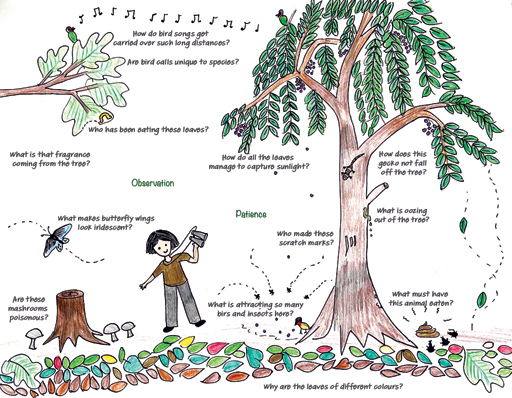
A mere 10-meter walk in the forest can expose you to an array of natural phenomena and sow the seeds of curiosity in our minds. Even a seemingly lifeless habitat like a scrubland offers so many opportunities to observe phenomena, think, explore, reason and discuss.
Let us assume that we take a walk in a rainforest. What kind of science can we learn from such a walk? Here are some questions that may come up.
Biology: Why is the forest floor so thick? What are the black and whitish patterns on the dead leaves? Why and how can such small beetles move such heavy balls of dung? How do snakes shed their skin? What does the scat (droppings of a wild animal) of a carnivore reveal about its diet? Why are there numerous butterflies gathering around a moist soil patch? What are the critters on the forest floor feeding on? How does this bird build its nest? Why do animals leave their scratch and scent marks on trees?
Chemistry: What is the forest soil composed of? Would it be acidic or basic? What is the gooey substance/sap that is coming out of the trees? What makes this sap sticky? What is this strong smell emanating from the tree? Why do ripened fruits fallen on the forest floor have a peculiar smell? What salts and minerals can I find in this forest stream? What is this waxy coating on the leaf that prevents water from accumulating on it? Why do the rocks in this region have a reddish hue?
Physics: How do all the leaves in this dense forest manage to capture sunlight? How do bird-calls get carried over such long distances? How can such a tiny bird endure the cold temperatures of a winter morning? How does the tree gecko manage to move upside-down on the tree branch? Why does it not fall off? How does an owl or bat hunt in complete darkness? What makes the falcon so fast in flight? Why does the bird’s colour look different at different angles?
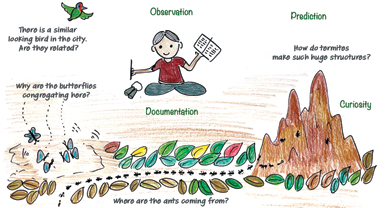
Each of the above questions has the potential to lead you into the depths of biology, chemistry and physics. More interestingly, many of these questions can be approached in an interdisciplinary way. For example, the question, ‘Why and how can such small beetles move such heavy balls of dung?’ may be approached from a biology and a physics perspective. Many of these questions have, of course, already been addressed by the scientific community after systematic and rigorous research and experiments. However, for educators, these questions offer a starting point for simple scientific investigations. An educator need not dwell into the specifics and depth of the sciences, but rather introduce many concepts and theories using nature as a trigger to spark curiosity.
Not surprisingly, nature has also inspired a lot of the technology that human beings have invented and developed over the years. For example, as we all know, energy generation from renewable sources has been a cutting-edge research and development area. In recent times, scientists have studied the fins of the whale (marine mammals) to redesign the blades of turbines with an intent of making them more efficient. This field is more broadly known as ‘biomimetics’ which attempts to emulate models, systems and elements of nature with the intention of solving various technological problems in society. The field of biomimetics has gained huge traction in recent times owing to its unique approach to solving problems.
Another pragmatic way to look at nature is that it helps us practice the scientific methodology, or in simpler words in “doing” science. For example, let us take the simple task of nature journalling. When a group of children are asked to observe and document some aspect of nature, like birds and their behaviour, they engage in a range of skills that are central to any scientific endeavour. During such a task, they study and share their observations with their peers. They can hypothesize the reasons for certain observations. Not only this, observing aspects of nature, maintaining logs and referring to multiple sources to gain information which is integral to any science, can also be a painstakingly tedious process, thereby allowing children to develop the skills of patience and perseverance in the process. All the tasks elucidated above – asking questions, hypothesizing, collecting data, systematically documenting it and looking for patterns, etc., – form part of the scientific methodology.
Doing and learning science from nature also helps us understand the very “nature” of science (NoS). The “nature” referred to here is the basic character or inherent features or qualities of something. Sounds confusing? Basically, Nature of Science (NoS) is a key component of scientific literacy, which contributes to how one perceives and understands science as a subject. NoS is relevant because educators and researchers have argued that a sound understanding of NoS helps one make informed decisions on issues that are related to science and society.
Typically, one views science as being purely objective with no scope of subjectivity. It is also often perceived as being an absolute and static body of knowledge. However, these notions are far from what science is in reality. As mentioned above, doing science in nature helps students to be speculative with the tentative knowledge they gain each day. They are willing to change their opinions in light of new observations (evidence) and over time this will lead to accepting ‘knowledge’ that is durable.
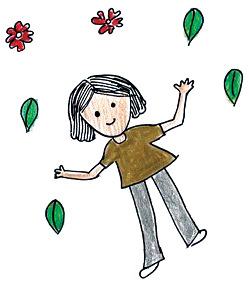
For example, towards the end of World War II, Dichlorodiphenyltrichloroethane, commonly known as DDT, became a revolutionary chemical that was used to inhibit the spread of insect-borne diseases like typhus and malaria in human beings. The drug was so effective that it was used almost everywhere with little attention paid to its after-effects or side-effects. Though it was believed that several farmers, journalists, lawmakers and citizens raised objections to the use of DDT, the anti-DDT movement did not gain major traction until Rachel Carson, an American environmentalist, in 1962 extensively described the harmful effects of DDT in her book Silent Spring. Her meticulous work with respect to DDT’s effects on falcons, salmon, eagles and other wildlife called for a serious reconsideration of DDT being used in the environment so callously. Eventually, DDT was banned in the United States of America in the early 1970s. Here, we see how rigorous studies may be designed in nature which lead to gathering evidence to challenge long-standing scientific knowledge.
Let us consider another example closer to our local contexts. Science textbooks or reference books commonly present that ‘sparrows are granivores, which means they feed on seeds or grains’. However, if we were to observe sparrows in nature, we can see them feeding on other types of food as well, including insects! Sparrows can be opportunistic feeders and may change to a protein rich diet (insects) during breeding season. While they might mostly feed on seeds and grains, observations will show that this is not an absolute statement. Such skepticism and contradictory observations (to formal text) provide opportunities to discuss and debate what children may have observed and read in other books, reports and papers. This supports an ethos where children can learn and work with each other and build on each other’s thoughts and ideas. It also indirectly indicates how science is a social enterprise and a lot of it depends on cooperation and working alongside your peers.
In summary, one may view nature to be a good starting point to address the various aspects of science as shown below.
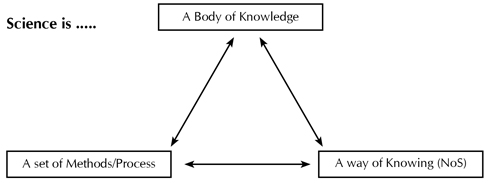
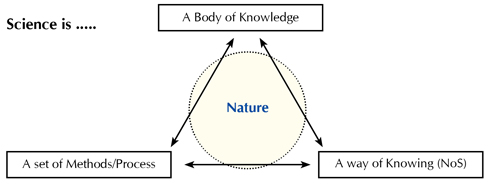
Last but not the least, one cannot dispute the fact that learning amidst nature can help us re-connect with our natural world. While the physical and mental benefits of nature have time and again been explicated by researchers worldwide, one can always use the opportunity to learn science from nature as a way to also mend our dwindling connection with nature.
Acknowledgments: I am grateful to Dr. Deborah Dutta and Dr. Suravi Kalita for their constructive feedback. I also acknowledge the support of the Government of India, Department of Atomic Energy, under Project Identification No. RTI4001.
References
• Bell, R. L. (2009). Teaching the nature of science: Three critical questions. Best practices in science education monograph. Carmel, CA: National Geographic School Publishing.
• Carson, R. (2000). Silent spring. London: Penguin Modern Classics.
• Cormell, J. & Ivey, T. (2012). Nature journaling: Enhancing students’ connections to the environment through writing. Science Scope 35, 38-43.
• Greene, E. (2011). Why keep a field notebook. In M.R. Canfield (Ed.), Field notes on science and nature (pp. 251-274). Cambridge, MA: Harvard University Press.
• Knight, S. (2013). Forest school and outdoor learning in the early years. UK: Sage.
• Lederman, N.G. (1992). ‘Students’ and teachers’ conceptions of the nature of science: A review of the research. Journal of Research in Science Teaching (29), 331-359.
• Muralidhar, A., & Krishnan, A. (2021). Rediscover, describe, and draw birds. In B. Choksi, G. Date, A. Gupta, R. Mani and K. Subramaniam (Eds.), Exploring science and mathematics with Vigyan Pratibha Learning Units, Class 8: Teacher Version (pp. 105-136). Mumbai: HBCSE.
• Schwartz, R., & Lederman, N. G. (2002). ‘It’s the nature of the beast’: The influence of knowledge and intentions on learning and teaching nature of science. Journal of Research in Science Teaching, Vol 39(3), 205-236. DOI: 10.1002/tea.10021
• Van Nierop, E. A., Alben, S., & Brenner, M. P. (2008). How bumps on whale flippers delay stall: An aerodynamic model. Physical Review Letters 100, 054502.
The author works at the Homi Bhabha Centre for Science Education, TIFR, Mumbai. She also runs a nature blog called Earthly Notes (www.earthlynotes.com) and can be reached at adithi@hbcse.tifr.res.in.
Additional Reading
